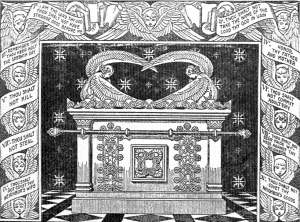 Moses was with God in the mountain for forty days and nights. When he went down, his face was radiant from his talk with God, and sent forth rays like horns. The Israelites could not look upon him, so that Moses had to cover his face with a veil.
Moses was with God in the mountain for forty days and nights. When he went down, his face was radiant from his talk with God, and sent forth rays like horns. The Israelites could not look upon him, so that Moses had to cover his face with a veil. Moses was with God in the mountain for forty days and nights. When he went down, his face was radiant from his talk with God, and sent forth rays like horns. The Israelites could not look upon him, so that Moses had to cover his face with a veil.
Moses was with God in the mountain for forty days and nights. When he went down, his face was radiant from his talk with God, and sent forth rays like horns. The Israelites could not look upon him, so that Moses had to cover his face with a veil.
Moses at once built the Tabernacle, which was divided into two parts: the Holy of Holies, and the Sanctuary. The Holy of Holies housed the Ark of the Covenant. which contained the Tables of Law.
In the Sanctuary were the Show Bread, the seven-branched candlestick, and the Altar of Incense. The altar of holocausts, upon which the sacrifices were offered in sight of the people, and the brazen basin in which the priests purified themselves before any sacred ceremony, were in the portico surrounding the Tabernacle.
The Ark was a figure of the tabernacle in Catholic churches; the Holy of Holies, of the altar on which Mass is said; the Sanctuary, of the place occupied by our priests; and the portico, of the body of the church, where the people now worship.
The Show Bread, consisting of twelve loaves, was a figure of the Blessed Eucharist, daily offered to God in thanksgiving for all His graces. The seven-branched candlestick symbolized the Holy Ghost and His seven gifts in the Church.
The sacrifices of the Old Law were either bloody, in which were offered animals; or unbloody, in which were offered cakes and unleavened bread and wine. The bloody sacrifices prefigured the bloody sacrifice of Christ upon the Cross; the unbloody were a type of the Sacrifice of the Mass. The sacrifices of the Old Law ceased with the Sacrifice of Christ on Calvary. Today we have only one true Sacrifice: Holy Mass.
The chief religious feasts were: the Pasch or Passover, in memory of the deliverance out of Egypt; Pentecost, in remembrance of the Law received from Mount Sinai; the Tabernacles to commemorate the wanderings in the desert; and the Expiation, in which the priest sacrificed for his own and his people's sins.
God also gave rules about the priesthood. The order of ministers was: the high-priest, the priests, and the Levites.
By God's command, the people were to support the priests and Levites serving at the altar. In the same way, we have that obligation to support the priests of our Church.
- from My Bible History in Pictures, by Bishop Louis LaRavoire Morrow, D.D., 1934; it has the Imprimatur of Archbishop Michael J O'Doherty of Manila, Philippines